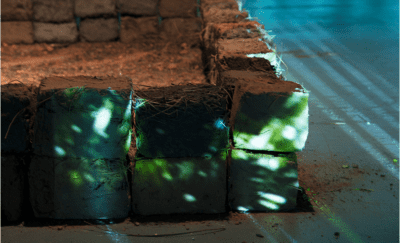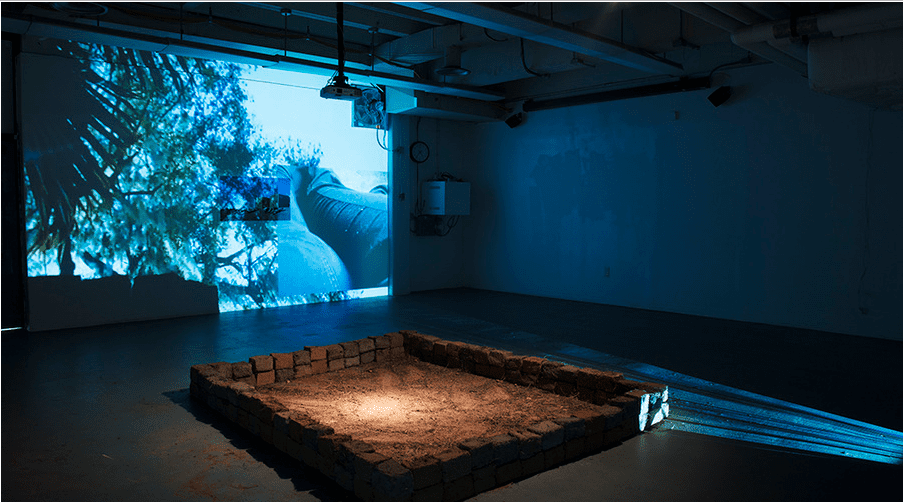Jezabeth Roca Gonzalez is an interdisciplinary MFA student at the University of South Florida in Tampa. Originally, from the rural town of Añasco on the island of Puerto Rico, Gonzalez has resided in the United States for the past ten years. Her work centres around her Latinx identity, exploring themes of distance, displacement, citizenship, colonialism, bridging two cultures, and the healing power of family.
This month, she took part in a residency with the Feminist Art Collective at Artscape Gibraltar Point, and she’ll be presenting her work this Saturday at an Open Studio Exhibition.
We asked her about the project this week.
SDTC: Over the course of the residency, how did your project evolve from your initial intention for it?
JRG: Right before coming to the FAC residency, I was finishing a thesis proposal for the following year and beginning a researching position for a VR project on micro-aggressions. I felt burnt out, and extremely weighted. “Fabrication of Self” is a work that has manifested in various forms, and every time, I see it as an extension of itself, not completely separate projects. My work begins with my commitment to my family, our collaborative approach, the island of Puerto Rico, tensions with the United States and the complexities that myself and my family members face daily while existing in a colonial space.
Did you come across anything in your research for this project that really surprised you or shifted your perspective?
I was open to learning. I made it a goal to become a better listener and to personally let go of some labour-intensive (yet unproductive) ways of working.
During our workshops and lectures, listening to Indigenous activist Trina Moyan (Nehiyaw) from First Story Toronto resonated with me. I felt like I was listening to my grandparents or elders from my Latinx community in Puerto Rico tell stories. There are a lot of similarities between the island of Puerto Rico and some Indigenous communities here, especially in relation to the land, family, colonization histories and ways of thinking. I wasn’t necessarily surprised with this information, but it made me relate to the island and the land differently. Trina asked us to honour the land and those before us, which is something that I had been actively thinking about during my time here. Travelling here, I was lucky to have a passionfruit seed in my bag. I tried germinating the seed and gifting it to the land. From one island to another. As a gesture of gratitude.

“Fabrication Of Self ” La sala de mis abuelos (My grandparents Livingroom)
Adobe brick house foundation, Florida Sand, Puerto Rico Dirt.
Why is it important to you to highlight the tension in trying to bridge two cultures? How has this tension shaped your identity?
Honestly, it is unfair to have a voice in art where the conversation revolves around Puerto Rico and not speak about the clear tension in its relationship with the United States. My narrative is a migrant’s narrative; it is something I would encounter before I even left the island. The diaspora was always in the conversation.
I think my identity is constantly shifting because of this narrative and I’m sure it will continue to do so. Being othered is a daily thing; there are no breaks from it. Even at this point, when travelling back to Puerto Rico, I have this feeling, because I am not a permanent body there, even though I feel more at home once I land in the Aguadilla airport.
How did the residency expand your artistic practice?
I really enjoyed listening to activists talk about their commitment to communities. I loved being on an island again, even if it’s different from my island, surrounded by a group of people and artists who are committed to their practice and research. I feel like being here has been all about learning. I was in Toronto last year as a visiting artist for the Nuit Rose Queer and Performance Festival for Toronto Pride and felt welcomed by groups of people who predominantly had migrant/immigrant narratives and felt proud of being in Toronto. It was a really interesting perspective to me, to be so open about your narrative, which allows for multiple conversations to take place when referring to a migrant/immigrant narrative.
I was hoping that the Feminist Art Conference Residency would allow me to continue learning and understanding the narratives of Toronto and partake in the conversation as well. I am grateful to had been accepted and to everyone who facilitated this learning experience.
What do you hope audiences take away from your exhibit?
I hope that people can connect to Puerto Rico in one way or another. I think the work that is made in collaboration with my family or by myself has many layers. My hope is that people are prepared to pick through them and investigate as well.



 Follow Us On Instagram
Follow Us On Instagram
